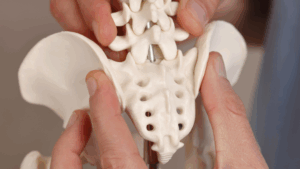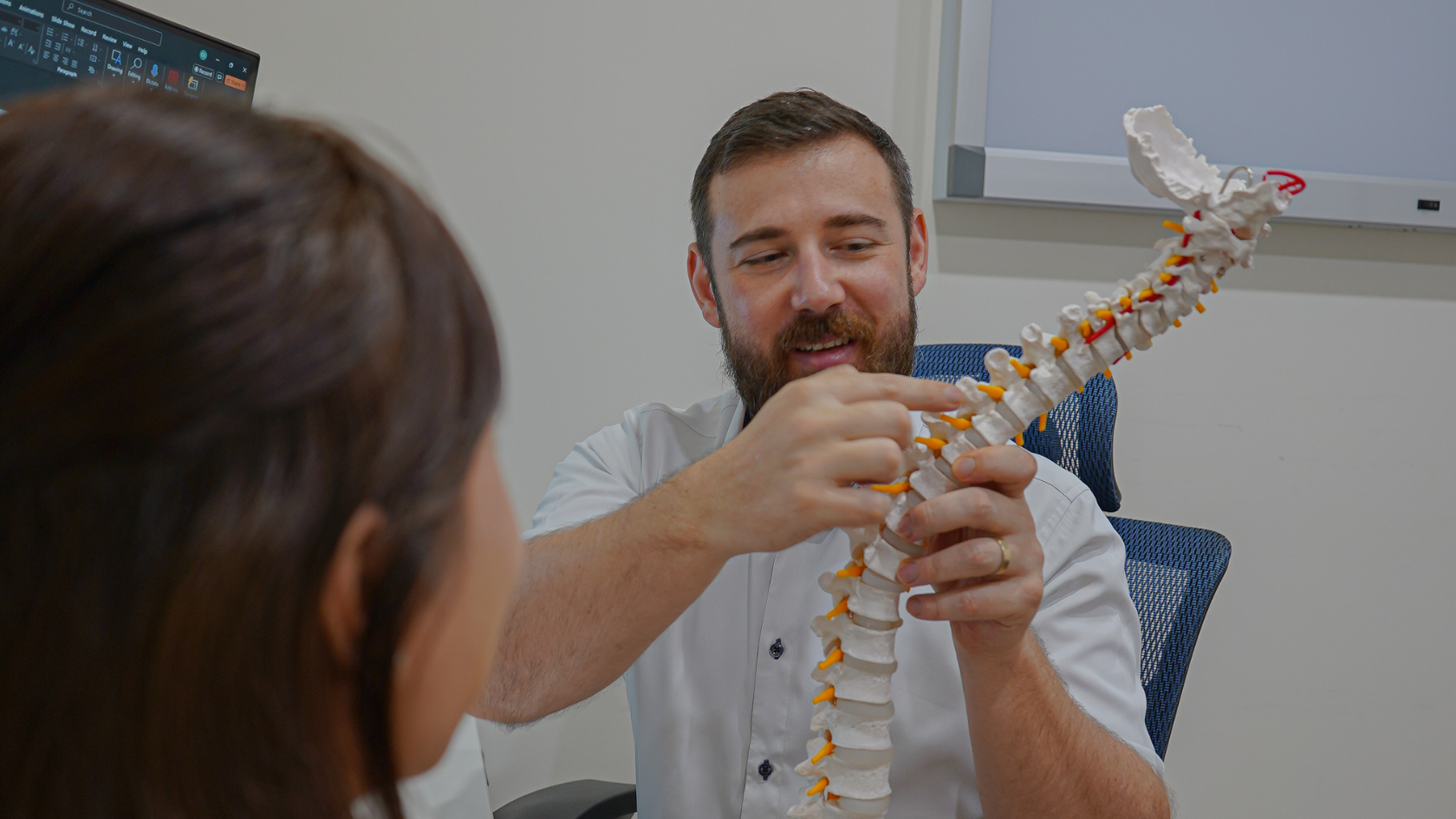At Chiropractic Singapore, we know how disruptive tailbone pain when sitting can be. From struggling to stay focused at work to avoiding long commutes or social activities, the discomfort often goes beyond physical pain. It can affect your productivity, your confidence, and even your enjoyment of everyday life.
The coccyx — or tailbone — may be small, but its role in supporting your body when seated and stabilising the pelvis makes it an important part of your spinal health. If you’ve been searching for lasting relief, we’re here to explain why tailbone pain happens, what you can do at home, and how professional care can make a difference.
Understanding the Tailbone or Coccyx
The tailbone, or coccyx, is a small triangular bone located at the very base of the spine. Although it may seem insignificant because of its size, it is made up of three to five fused vertebrae that serve as an important anchor point for various muscles, ligaments, and tendons. These soft tissues contribute to **pelvic stability, balance, and movement**, especially when you shift from sitting to standing or lean forward.

Despite its small structure, the coccyx plays a crucial role in bearing weight when seated. When you sit down, particularly on hard or uneven surfaces, much of your body weight is distributed through the tailbone. This is why discomfort in this area often becomes more noticeable during prolonged sitting.
Beyond sitting, the tailbone also works with surrounding muscles to support proper posture and contributes to core stability. Any injury, strain, or misalignment affecting the coccyx can therefore have a ripple effect on your comfort, mobility, and overall spinal health.
Symptoms and Causes of Tailbone Pain
Tailbone pain, or coccyx, can range from mild discomfort to sharp, persistent pain. Recognising the symptoms and their common causes helps in knowing when self-care is enough and when professional support may be needed.
| Tailbone Pain Symptoms | Tailbone Pain Description | Common Causes of Tailbone Pain |
|---|---|---|
| Localised pain | Aching or sharp pain at the base of the spine, worse when sitting. | Trauma, prolonged sitting, poor posture. |
| Pain on movement | Discomfort when rising from a chair. | Injury, repetitive strain, age-related changes. |
| Worsening with sitting | Increased pain on hard or narrow surfaces. | Prolonged sitting, obesity, poor posture. |
| Tenderness to touch | Sensitivity around the coccyx when pressed. | Bruising, inflammation, injury. |
| Radiating pain | Discomfort spreading to hips, buttocks, or thighs. | Postural strain, childbirth injury, degeneration. |
| Stiffness | Reduced mobility after sitting too long. | Sedentary habits, poor ergonomics. |
| Difficulty leaning back | Pain when reclining, leading to forward-leaning posture. | Pelvic misalignment, repetitive strain. |
While mild cases may improve with simple chiropractic adjustments, persistent or worsening symptoms should be assessed to identify and address the root cause.
Why do I have tailbone pain when sitting?
The way you sit every day can significantly influence the health of your tailbone. Poor sitting habits may gradually strain the coccyx and surrounding muscles, leading to discomfort or persistent tailbone pain. By becoming more aware of your posture and daily habits, you can reduce unnecessary pressure and protect your spinal health.

| Sitting Habit That May Cause Tailbone Pain | How It Affects the Tailbone | Healthier Alternative |
|---|---|---|
| Prolonged sitting on hard chairs | Direct pressure on the coccyx, causing soreness and inflammation | Use a cushioned, ergonomic chair or a doughnut-shaped cushion |
| Slouching or leaning back excessively | Stretches ligaments and misaligns the lower spine | Sit upright with natural lumbar support |
| Frequently crossing legs | Creates uneven pelvic pressure, straining the coccyx | Keep both feet flat and knees aligned |
| Sitting still for hours | Reduces blood flow, stiffens the spine, and increases coccyx tension | Take breaks to stand, stretch, or walk every 30–60 minutes |
| Sitting without adequate back support | Overworks supporting muscles and shifts pressure to the coccyx | Use a supportive backrest or lumbar cushion |
Making small adjustments to your sitting posture and environment can go a long way in easing tailbone pain and supporting long-term spinal health.
Is It Better to Stand at Work to Prevent Tailbone Pain?
When it comes to tailbone health, the most effective solution isn’t standing all day—but alternating between sitting and standing.
How Standing Helps Your Tailbone
- Reduces coccyx pressure: Standing takes the load off your tailbone, which often absorbs undue pressure during prolonged sitting—especially on hard or unsupportive surfaces.
- Promotes movement and circulation: Alternating between postures increases blood flow and prevents muscular stiffness around the lower spine, reducing tailbone tension.
- Improves posture: Standing naturally encourages a neutral spine, reducing slouching or pelvic misalignment that can strain the coccyx.
Best Practices to relief tailbone pain: Balanced Sitting and Standing
| Practice | Tailbone-Friendly Benefit |
|---|---|
| Alternate every 30–60 minutes | Relieves pressure, boosts circulation, reduces coccyx strain |
| Start with short standing intervals | Prevents fatigue and leg strain while easing into new habits |
| Maintain ergonomic setup | Keep screen at eye level, elbows at ~90°, and avoid locking knees |
| Pair with cushions when seated | Coccyx or contoured U/V cushions can provide direct relief during sitting sessions |
Other Risk Factors That Increase Tailbone Pain
Several factors can make you more vulnerable to developing or prolonging tailbone pain. These risks often combine lifestyle, biological, and occupational influences:
- Obesity causes tailbone pain – Carrying excess weight places greater pressure on the coccyx, particularly during extended sitting.
- Rapid weight loss causes tailbone pain – Losing fat padding around the tailbone reduces its natural cushioning, leaving the coccyx more exposed to pressure and irritation.
- Ageing causes tailbone pain – With age, conditions such as arthritis, joint degeneration, or bone spurs may develop, making the coccyx area more prone to pain.
- Gender – Women are more susceptible due to differences in pelvic structure, hormonal changes, and added strain during pregnancy and childbirth.
- Sedentary lifestyle causes tailbone pain – Long hours of uninterrupted sitting reduce circulation, stiffen muscles, and place sustained stress on the coccyx.
- Occupational demands may cause tailbone pain – Jobs or routines that require prolonged sitting, such as driving or desk work, significantly increase the likelihood of tailbone discomfort.
By recognising these risk factors, you can take preventive steps — such as improving posture, using supportive seating, and incorporating movement into your daily routine — to reduce the chances of persistent coccyx pain.
Tailbone pain exercises
Gentle, consistent movement is one of the best ways to reduce discomfort and restore flexibility in the coccyx region. Exercises, such as pelvic tilts, child’s pose, seated forward bend and cat-cow stretch, can relieve tension, improve posture, and strengthen the muscles that support your pelvis and lower spine.
Pelvic Tilts for Tailbone Pain

Lie on your back with knees bent and feet flat. Tighten your core and press your lower back into the floor, holding briefly before relaxing. This simple motion strengthens abdominal and pelvic muscles, improving stability around the tailbone.
- Hold for 5–10 seconds, then relax.
- Repeat 10–12 times.
✅ Strengthens the core and supports pelvic alignment.
Child’s Pose Stretch (Yoga) for Tailbone Pain

From a kneeling position, sit back onto your heels and extend your arms forward, lowering your torso between your thighs. This restorative stretch lengthens the spine, eases coccyx pressure, and encourages relaxation.
- Hold for 20–30 seconds.
✅ Relieves tension in the lower back and coccyx area.
Seated Forward Bend for Tailbone Pain

Sit tall with legs extended in front of you. Hinge forward at the hips and reach toward your toes without forcing the stretch. This gentle movement eases tension in the lower back and hips.
- Stop at a comfortable stretch without rounding the spine.
✅Stretches hamstrings and reduces pulling on the lower back and tailbone.
Cat-Cow Stretch for Tailbone Pain

On hands and knees, inhale to arch your back and lift your tailbone (cow), then exhale to round your spine and tuck your chin (cat). This flow improves spinal mobility and reduces stiffness around the coccyx.
- Repeat 8–10 times.
✅ Improves spinal mobility and eases pressure around the coccyx.
Tailbone Pain During Pregnancy
Many expectant mothers experience tailbone pain during pregnancy, especially in the later stages. As the baby grows, the body’s centre of gravity shifts, placing greater pressure on the pelvis and coccyx. At the same time, the hormone relaxin, which prepares the body for childbirth by loosening ligaments, can reduce stability in the pelvic region and increase strain on the tailbone.

In some cases, the tailbone may also be affected during labour or delivery, which can result in ongoing postpartum discomfort. For mothers already coping with the physical changes of pregnancy, this added pain can make daily activities like sitting, standing, or sleeping even more challenging.
At Chiropractic Singapore, we provide gentle, pregnancy-safe care designed to support both comfort and wellbeing. Our approach focuses on:
- Easing pressure on the spine and coccyx to reduce pain.
- Promoting pelvic balance and stability to help the body adapt more comfortably to pregnancy changes.
- Sharing posture and lifestyle guidance so that sitting, resting, and sleeping positions place less strain on the tailbone.
With tailored support, many expectant and new mothers find relief, making it easier to enjoy this important stage of life with greater comfort and confidence.
How to Alleviate Tailbone Pain Naturally with Chiropractic Care
At Chiropractic Singapore, our approach goes beyond temporary relief. Chiropractic care addresses the underlying causes of tailbone pain when sitting by focusing on spinal health, posture, and musculoskeletal balance.
 1. Spinal Alignment for Tailbone Pain
1. Spinal Alignment for Tailbone Pain
Misalignments in the pelvis or lower spine can place uneven stress on the coccyx. Gentle adjustments aim to restore balance, easing strain and improving comfort when seated.
2. Reduce Muscle Tension for Tailbone Pain
Tightness in surrounding muscles, such as the glutes and pelvic floor, can worsen coccyx pain. Chiropractic techniques help release tension and promote flexibility.
3. Posture and Ergonomic Guidance for Tailbone Pain
We offer personalised advice for sitting, working, and driving. Correcting posture habits reduces ongoing coccyx stress.
4. Pregnancy Support for Tailbone Pain
Expectant mothers benefit from safe, gentle care tailored to reduce pelvic strain and improve sitting comfort throughout pregnancy.
5. Personalised Exercises for Tailbone Pain
We may prescribe specific tailbone pain exercises to strengthen support muscles, stabilise the pelvis, and aid recovery.
Taking the Next Step Towards Tailbone Pain Relief
What begins as mild tailbone discomfort can soon interfere with daily life—making work, travel, and even simple moments of rest uncomfortable. You don’t have to live with that constant ache.
At Chiropractic Singapore, we take a holistic and personalised approach to care, focusing on easing pressure, improving alignment, and supporting long-term spinal health. Our goal is to help you move, sit, and live with greater comfort—naturally and safely.
Book your consultation today and take the first step towards lasting relief from tailbone pain when sitting.
FAQ’s About Tailbone Pain
1. Can tailbone pain go away on its own without treatment?
In some cases, mild tailbone discomfort may ease over time with rest, posture adjustments, or the use of cushions for support. If symptoms continue or become more severe, it is advisable to seek professional assessment to understand the underlying cause.
2. Is it safe to exercise with tailbone pain?
Gentle, low-impact activities such as walking, stretching, or swimming are usually safe and may support mobility. Exercises that place direct pressure on the tailbone, such as sit-ups on hard surfaces, may increase discomfort and are best avoided unless guided by a qualified professional.
3. What’s the difference between tailbone pain and lower back pain?
Tailbone pain is felt at the very base of the spine, often worsening when sitting, while lower back pain is usually located higher in the lumbar region. As the two can sometimes overlap, a professional consultation can help clarify the source of discomfort.
4. When should I see a professional for tailbone pain?
You should seek help if pain lasts more than two weeks, worsens despite home remedies, or interferes with sitting, standing, or sleep. Persistent pain after pregnancy or injury also warrants a professional evaluation to rule out underlying issues and ensure proper recovery.










